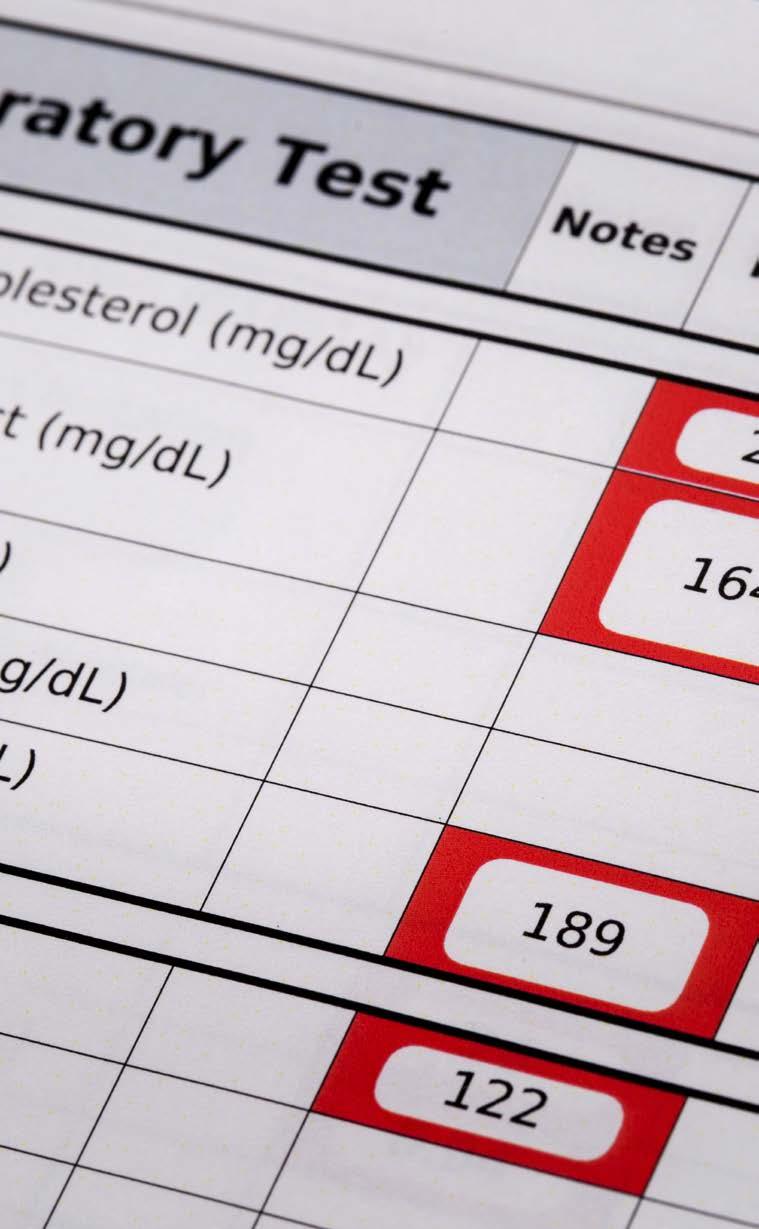




Cholesterol, a waxy substance found in the blood, plays a vital role in various bodily functions, including cell membrane formation and hormone production. However, elevated levels of cholesterol, particularly low-density lipoprotein (LDL) cholesterol, commonly known as “bad cholesterol,” can contribute to significant health risks such as strokes and heart attacks, which disproportionately affect Black Americans (Mayo Clinic, 2023). Conversely, a low level of high-density lipoprotein (HDL) cholesterol, often referred to as “good” cholesterol can also be concerning, as it is associated with a heightened risk of heart disease (Biggers, 2023). Optimal health entails achieving high levels of HDL cholesterol, while keeping LDL cholesterol at low levels. Maintaining this balance is essential for reducing the risk of heart disease and stroke.

Black individuals experience higher rates of heart disease and stroke compared to counterparts from other racial or ethnic backgrounds (Seth S. Martin, 2024). Where high cholesterol prevalence and incidence rates are elevated, the burden of cardiovascular diseases is disproportionately high (Seth S. Martin, 2024).
• Among men, non-Hispanic white individuals exhibit the lowest incidence of high LDL cholesterol, standing at 29.4%, compared to non-Hispanic Black men with 30.7% and Mexican American men with the highest incidence at 38.8% (Salamon, 2024).
• For women, the rates are nearly identical between non-Hispanic white and Mexican American women, both at 32% and 31.8%, respectively, while non-Hispanic Black women show a slightly higher incidence of high LDL cholesterol at 33.6% (Salamon, 2024).
• During 2015–2018, approximately 11.4% of adults were reported to have high total cholesterol, with prevalence rates similar across different racial and Hispanic origin groups (Carroll, 2020).
• The prevalence of high total cholesterol was highest among adults aged 40–59.
FIGURE 1— TRENDS IN AGE-ADJUSTED PREVALENCE OF HIGH TOTAL CHOLESTEROL AND LOW HIGH-DENSITY LIPOPROTEIN CHOLESTEROL AMONG ADULTS AGES 20 AND OVER: UNITED STATES, 1999-2000 THROUGH 2017-2018 (CARROLL, 2020).

CPAR | Understanding Cholesterol Disparities in the Black Community
Research indicates a pattern in the levels of LDL, commonly referred to as “bad cholesterol,” in Black men. While both Black men and women demonstrated somewhat higher levels of HDL, often deemed as the good cholesterol, the association reveals that 32.4 percent of Black men have “borderline-high” or high LDL levels (Lee-Frye, 2022).
2— PREVALENCE OF LOW HIGH-DENSITY LIPOPROTEIN CHOLESTEROL AMONG ADULTS 20 AND OVER, BY SEX AND AGE: UNITED STATES, 2015-2018 (CARROLL, 2020)

In the Black community, several factors contribute to the prevalence of high cholesterol levels including dietary habits, obesity, physical activity levels, smoking, alcohol consumption, and age (Mayo Clinic, 2023). Certain factors, such as age and family history, are beyond individual control, while others, like diet and exercise, are modifiable.
• High Blood Cholesterol is a significant risk factor for heart disease, with several factors contributing to unhealthy cholesterol levels. Among these are the consumption of excessive saturated and trans fats, prevalent in fatty meats, full-fat dairy products, and packaged snacks (Mayo Clinic, 2023).
• Obesity, defined by a BMI of 30 or greater, also increases the risk of high cholesterol, and predisposes individuals to an elevated risk of heart disease and diabetes. Moreover, obesity significantly impacts individuals with pre-existing high cholesterol levels, heightening their susceptibility to cardiovascular complications (Salamon, 2024).
• Smoking and excessive alcohol consumption are detrimental to cholesterol health as they have been shown to lower levels of HDL while simultaneously raising levels of LDL (Mayo Clinic, 2023). This imbalance in cholesterol levels increases the risk of plaque buildup in the arteries, leading to atherosclerosis and other cardiovascular diseases (American Heart Association, 2023).
• Age plays a role, as individuals over 40 are more susceptible to unhealthy cholesterol levels due to decreased liver function, negatively impacting the removal of LDL cholesterol (Mayo Clinic, 2023).
• Type 2 Diabetes has been linked to reduced levels of HDL and increased levels of LDL (Centers for Disease Control and Prevention, 2023). This dual effect significantly elevates the risk of heart disease and stroke among individuals with diabetes (Centers for Disease Control and Prevention, 2023).
• Familial hypercholesterolemia can lead to exceptionally high levels of LDL cholesterol, further increasing the risk of cardiovascular complications (Centers for Disease Control and Prevention, 2023).
Today, Black Americans experience higher mortality rates for both heart disease and cancer, the two leading causes of death in the United States (Lee-Frye, 2022). Racial disparities, genetic predispositions, lifestyle factors such as diet and physical activity, socioeconomic factors, and access to healthcare all play significant roles in shaping cholesterol levels among Black individuals (Seth S. Martin, 2024; Salamon, 2024). Each of these racial disparities contributes to the prevalence of high cholesterol and ultimately leads to higher mortality rates among Black Americans compared to their white counterparts.
GENETIC PREDISPOSITIONS
One’s genetic makeup plays a significant role in how their body metabolizes food and produces cholesterol. Notably, cholesterol production is primarily regulated by the liver, which generates approximately 75% of one’s blood cholesterol (Lee-Frye, 2022). Genetic factors influence the rate of cholesterol production and the balance between LDL and HDL cholesterol levels (Lee-Frye, 2022).
While cholesterol health may not be solely determined by genetics, individuals with a family history of high cholesterol are at an increased risk of developing high cholesterol themselves (Centers for Disease Control and Prevention, 2023). As such, they may require more frequent cholesterol screenings compared to those without a family history of high cholesterol. Furthermore, individuals with a family history of high cholesterol who do not adhere to a heart-healthy diet, lead a sedentary lifestyle, or engage in smoking may be at risk of high cholesterol (Centers for Disease Control and Prevention, 2023).
Individuals with lower socioeconomic status tend to experience poorer health outcomes when faced with illness. These socioeconomic factors including one’s education level, employment status, income level, and environmental conditions contribute significantly to their increased risk of imbalanced LDL and HDL cholesterol levels (Mammoser, 2023). Black individuals maintain an elevated risk profile even after adjusting for health behaviors, including smoking, poor diet, physical activity, and access to healthcare (Williams, 2010). Furthermore, Black Americans do not experience the same improvements in health as their white counterparts, with the racial disparity being most pronounced at the highest levels of socioeconomic status (Williams, 2010). Additionally, residential segregation based on race has resulted in racial groups in the United States inhabiting distinct neighborhood environments, with varying levels of social conditions (Williams, 2010). These neighborhood and community-level social conditions play a crucial role in driving racial differences in health outcomes with ample data available to assess the impact of socioeconomic status on the racial health disparities in cholesterol health (Williams, 2010). Increased cardiovascular health education is pertinent to addressing the long-standing health inequities that affect the Black community.
Several lifestyle factors specific to Black individuals in America can contribute to negative trends in cholesterol health. These factors may include dietary habits influenced by cultural preferences, such as the consumption of traditional foods that are high in saturated fats and cholesterol. Limited access to affordable healthy foods and healthcare services can also impact lifestyle choices and contribute to higher rates of obesity and sedentary behavior among Black Americans. Moreover, historical and systemic inequities may lead to higher levels of stress, which can further exacerbate cholesterol levels and cardiovascular health (Centers for Disease Control and Prevention, 2023).

Disparities between racial and ethnic groups also arise due to unequal access to healthcare or cultural disparities in attitudes toward medical treatment, leading to Black Americans being disproportionately underserved compared to the white population (Mayo Clinic, 2023). Black Americans and Hispanics are less likely than whites to undergo blood cholesterol level screenings (Salamon, 2024).
Amgen , the marketer of the advanced cholesterol treatment “Repatha,” is supporting a new initiative endorsed by the American Heart Association (AHA) called “Lower Your LDL Cholesterol Now.” This initiative aims to encourage individuals to request cholesterol level checks from their healthcare providers (Adams, 2023). Additionally, Amgen is providing support through a website operated by the AHA, which offers medical insights on LDL cholesterol, its associated risks, and strategies patients can implement to mitigate those risks. This initiative is particularly valuable as monitoring LDL cholesterol levels is a crucial step in preventing subsequent heart attacks or strokes (Adams, 2023).

The affordability and accessibility of cholesterol-lowering medications pose significant challenges for individuals within the Black community, often acting as barriers to adequate healthcare access. Limited financial resources and disparities in health insurance coverage may hinder individuals’ ability to afford necessary medications for managing high cholesterol levels. For example, significant disparities exist in insurance coverage across racial groups (Williams, 2010). Many racial minorities experience limited access to educational and employment opportunities, resulting in disproportionate representation in low-quality jobs that lack health insurance benefits (Williams, 2010). As a result, many individuals within the Black community may face difficulties in accessing essential cholesterol-lowering medications, leading to suboptimal management of their cholesterol levels.
Environmental factors also play a pivotal role in the elevated rates of high cholesterol among Black Americans, as race continues to be a significant determinant of various environmental risks and exposures in contemporary society (Williams, 2010). These environmental factors encompass various aspects such as neighborhood conditions, equitable access to nutritious foods, safe recreational spaces, socioeconomic opportunities, and exposure to chronic stressors, all of which contribute to the disparities in cholesterol health observed within the Black American community. For instance, residential segregation often leads to the clustering of racial groups in neighborhoods with limited access to healthy food options and recreational facilities, known as “food deserts” and “activity deserts,” respectively. Socioeconomic status further exacerbates these disparities, as individuals residing in lower-income neighborhoods may face economic barriers to accessing fresh fruits, vegetables, and other nutritious foods, resorting instead to cheaper, processed options high in saturated fats and cholesterol. Additionally, chronic exposure to stressors such as discrimination, economic instability, and inadequate housing conditions can trigger physiological responses that contribute to dysregulated lipid metabolism and elevated cholesterol levels (Williams, 2010). Addressing these environmental determinants of health requires comprehensive policy interventions aimed at promoting equitable access to nutritious foods, safe recreational spaces, and socioeconomic opportunities for all communities.

Only older individuals are affected by high cholesterol, so younger community members do not need to worry about or pay attention to their cholesterol levels.
Cholesterol-lowering medications are unnecessary or ineffective.
High cholesterol can affect individuals of all ages. Most healthy adults over 21 should undergo cholesterol screenings every four to six years, with those who have heart disease, diabetes, or a family history of high cholesterol advised to undergo more frequent screenings (Lee-Frye, 2022). Early awareness and proactive management of cholesterol levels are crucial for preventing longterm health complications.
Cholesterol-lowering medications, when prescribed and taken as directed by healthcare professionals, have been shown to effectively lower cholesterol levels, reduce the risk of cardiovascular diseases, and improve overall health outcomes (Gao, 2023). However, while medications can be effective in managing high cholesterol, lifestyle modifications such as dietary changes, regular exercise, and smoking cessation are equally important components of cholesterol management (Centers for Disease Control and Prevention, 2023). In many cases, lifestyle interventions alone or in combination with medications can effectively lower cholesterol levels and reduce the risk of heart disease (Mayo Clinic, 2023).
Certain foods, such as those high in saturated fats and cholesterol, are integral to traditional diets and should not be limited or avoided, despite their potential impact on cholesterol levels.
Cholesterol only affects men, so women do not need to be concerned about their cholesterol levels.
Moderation and balance are key. Incorporating healthier alternatives and reducing the consumption of foods high in saturated fats and cholesterol can still honor cultural traditions while promoting better cholesterol health in the Black community (Centers for Disease Control and Prevention, 2023).
If you look and feel healthy, you do not need to worry about your cholesterol levels.
Both men and women are susceptible to high cholesterol and its associated health risks (Mammoser, 2023). In fact, heart disease is the leading cause of death for women in the United States (American Heart Association, 2023). Women should prioritize cholesterol screenings and adopt heart-healthy habits to reduce their risk of heart disease.
Cholesterol levels can be influenced by various factors beyond outward appearance and physical sensations. Even individuals who appear healthy may have high cholesterol levels, putting them at risk for heart disease and other cardiovascular complications (Mammoser, 2023). Regular cholesterol screenings are essential for detecting and managing high cholesterol, regardless of how one feels.
• Make Dietary Changes: Choose healthier options like fruits, vegetables, whole grains, lean proteins, and plant-based fats and reduce intake of saturated fats and cholesterolrich foods including:
• Sweet treats and pastries like donuts, cakes, and cookies
• Red meat, fatty meat, and highly processed meat
• Shortening, lard, tallow, and many fried foods
• Whole-fat dairy products such as milk, butter, cheese, and cream
• Exercise Regularly: Incorporate regular physical activity into your routine to help lower cholesterol levels and improve heart health. Aim for at least 30 minutes of moderate intensity exercise most days of the week.
• Quit Smoking: If you smoke, quit smoking to improve your cholesterol levels and overall cardiovascular health. Seek support from healthcare professionals or smoking cessation programs to help you quit.
• Limit Alcohol Intake: Limit alcohol intake to moderate levels, as excessive alcohol consumption can increase cholesterol levels. Stick to recommended guidelines for alcohol consumption to maintain heart health.
• Have Regular Cholesterol Screenings: Schedule regular cholesterol screenings with your healthcare provider to monitor your cholesterol levels and identify any potential issues early on. Follow your healthcare provider’s recommendations for frequency of screenings based on your individual risk factors.
• Adhere to Medication: If prescribed cholesterol-lowering medications, adhere to your medication regimen as directed by your healthcare provider. Take medications as prescribed and communicate any concerns or side effects to your healthcare provider.

• Impactful Policy Changes: Prioritize funding and supporting initiatives aimed at expanding access to healthcare services, particularly in underserved communities with high concentrations of Black individuals. Advocate for policies that prioritize LDL testing as part of routine healthcare screenings, especially within the Black community.
• Public Health Campaigns: Develop and implement public health campaigns that target the Black community to raise awareness about high cholesterol and its associated risks. Emphasize prevention strategies, such as dietary interventions and lifestyle modifications, to reduce the prevalence of high cholesterol. Focus on decreasing tobacco use, physical inactivity, and exposure to particle pollution to promote heart health within the Black community.
• Screening and Diagnosis: Highlight and expand existing programs for cholesterol screening and diagnosis targeting the Black community. Ensure access to regular cholesterol screenings and timely diagnoses to facilitate early intervention and management of high cholesterol. Develop culturally sensitive and linguistically appropriate programs to effectively reach and engage the Black community in cholesterol management initiatives.
Addressing the high prevalence and incidence rates of high cholesterol within the Black community requires increased awareness and knowledge, expanded access to healthcare, prioritization of LDL testing, and efforts to level socioeconomic factors. By enhancing awareness and knowledge surrounding cholesterol management and cardiovascular health, individuals within the Black community can make informed decisions about their health and take proactive steps to mitigate risk factors.

Adams, B. (2023, August 29). Amgen launches new ‘Lower Your LDL Cholesterol Now’ campaign backed by the American Heart Association. Retrieved from Fierce Pharma: https://www.fiercepharma.com/marketing/amgen-wants-you-loweryour-ldl-cholesterol-now-new-aha-backed-campaign
American Heart Association. (2023, August 23). Heart attack and stroke survivors neglect LDL cholesterol despite increased risk. Retrieved from Newsroom: https://newsroom.heart.org/news/heart-attack-and-stroke-survivors-neglectldl-cholesterol-despite-increased-risk#:~:text=According%20to%20the%20Centers%20for,of%20their%20LDL%20cholesterol%20number
Baciu A, N. Y. (2017). Communities in Action: Pathways to Health Equity. National Academies of Sciences, Engineering, and Medicine; Health and Medicine Division; Board on Population Health and Public Health Practice; Committee on Community-Based Solutions to Promote Health Equity in the United States.
Betancourt, J. M. (2004). The Institute of Medicine report “Unequal Treatment”: implications for academic health centers. Mt Sinai J Med, 314-21.
Biggers, A. (2023, November 23). Cholesterol and heart disease in African Americans. Retrieved from Medical News Today: https://www.medicalnewstoday.com/articles/cholesterol-and-heart-disease-in-african-americans
Carroll, M. D. (2020). Total and High-density Lipoprotein Cholesterol in Adults: United States, 2015–2018. Hyattsville, MD: National Center for Health Statistics.
Centers for Disease Control and Prevention. (2023, May 15). Know Your Risk for High Cholesterol. Retrieved from Centers for Disease Control and Prevention - Cholesterol : https://www.cdc.gov/cholesterol/risk_factors.htm
Gao, Y. S. (2023). US Trends in Cholesterol Screening, Lipid Levels, and Lipid-Lowering Medication Use in US Adults, 1999 to 2018. Journal of the American Heart Association
Lee-Frye, B. (2022, February 24). Cholesterol, Heart Disease, and African Americans. Retrieved from VeryWellHealth: https://www.verywellhealth.com/cholesterol-heart-disease-and-african-americans-3571756
Mammoser, G. (2023, November 2). Over 40% of Adults With High Cholesterol are Unaware and Aren’t Getting Treated Retrieved from healthline: https://www.healthline.com/health-news/over-40-of-adults-with-high-cholesterol-areunaware-and-arent-getting-treated
Mayo Clinic. (2023, January 11). High Cholesterol. Retrieved from Mayo Clinic Diseases and Conditions: https://www.mayoclinic.org/diseases-conditions/high-blood-cholesterol/symptoms-causes/syc-20350800
Salamon, M. (2024, February 10). The Connection Between Race and High Cholesterol. Retrieved from VeryWellHealth: https://www.verywellhealth.com/race-and-cholesterol-is-there-a-connection-698285#citation-1
Seth S. Martin, M. M.-S. (2024). 2024 Heart Disease and Stroke Statistics: A Report of US and Global Data From the American Heart Association. Circulation An American Heart Association Journal, e347 - e913.
Williams, D. R. (2010). Race, socioeconomic status, and health: Complexities, ongoing challenges, and research opportunities. Annals of the New York Academy of Sciences, 69-101.